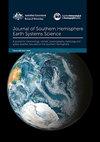Severe convection-related winds in Australia and their associated environments
IF 3.6
4区 地球科学
Q1 Earth and Planetary Sciences
引用次数: 9
Abstract
Severe surface wind gusts produced by thunderstorms have the potential to damage infrastructure and are a major hazard for society. Wind gust data are examined from 35 observing stations around Australia, with lightning observations used to indicate the occurrence of deep convective processes in the vicinity of the observed wind gusts. A collation of severe thunderstorm reports is also used to complement the station wind gust data. Atmospheric reanalysis data are used to systematically examine large-scale environmental measures associated with severe convective winds. We find that methods based on environmental measures provide a better indication of the observed severe convective winds than the simulated model wind gusts from the reanalysis data, noting that the spatial scales on which these events occur are typically smaller than the reanalysis grid cells. Consistent with previous studies in other regions and idealised modelling, the majority of severe convective wind events are found to occur in environments with steep mid-level tropospheric lapse rates, moderate convective instability and strong background wind speeds. A large proportion of events from measured station data occur with relatively dry environmental air at low levels, although it is unknown to what extent this type of environment is representative of other severe wind-producing convective modes in Australia. The occurrence of severe convective winds is found to be well represented by a number of indices used previously for forecasting applications, such as the weighted product of convective available potential energy (CAPE) and vertical wind shear, the derecho composite parameter and the total totals index, as well as by logistic regression methods applied to environmental variables. Based on the systematic approach used in this study, our findings provide new insight on spatio-temporal variations in the risk of damaging winds occurring, including the environmental factors associated with their occurrence.澳大利亚与强对流有关的风及其相关环境
雷暴产生的强烈地面阵风有可能破坏基础设施,对社会构成重大危害。研究人员分析了澳大利亚各地35个观测站的阵风资料,并利用闪电观测资料表明在观测到的阵风附近发生了深度对流过程。此外,天文台还收集了一组强雷暴报告,以补充该站的阵风资料。大气再分析数据用于系统地检查与强对流风有关的大规模环境措施。我们发现基于环境措施的方法比基于再分析数据的模拟模式阵风能更好地指示观测到的强对流风,注意到这些事件发生的空间尺度通常小于再分析网格单元。与以往在其他地区的研究和理想模式一致,发现大多数强对流风事件发生在对流层中层递减率陡、对流不稳定适中和背景风速强的环境中。从测得的台站数据中得到的大部分事件发生在相对干燥的低水平环境空气中,尽管尚不清楚这种类型的环境在多大程度上代表了澳大利亚其他严重的产风对流模式。研究发现,以前用于预报应用的一些指标,如对流有效势能(CAPE)和垂直风切变的加权乘积、derecho复合参数和总总量指数,以及应用于环境变量的logistic回归方法,都能很好地代表强对流风的发生。基于本研究中使用的系统方法,我们的研究结果为破坏性风发生风险的时空变化提供了新的见解,包括与其发生相关的环境因素。
本文章由计算机程序翻译,如有差异,请以英文原文为准。
求助全文
约1分钟内获得全文
求助全文
来源期刊

Journal of Southern Hemisphere Earth Systems Science
Earth and Planetary Sciences-Oceanography
CiteScore
8.10
自引率
8.30%
发文量
0
审稿时长
>12 weeks
期刊介绍:
The Journal of Southern Hemisphere Earth Systems Science (JSHESS) publishes broad areas of research with a distinct emphasis on the Southern Hemisphere. The scope of the Journal encompasses the study of the mean state, variability and change of the atmosphere, oceans, and land surface, including the cryosphere, from hemispheric to regional scales.
general circulation of the atmosphere and oceans,
climate change and variability ,
climate impacts,
climate modelling ,
past change in the climate system including palaeoclimate variability,
atmospheric dynamics,
synoptic meteorology,
mesoscale meteorology and severe weather,
tropical meteorology,
observation systems,
remote sensing of atmospheric, oceanic and land surface processes,
weather, climate and ocean prediction,
atmospheric and oceanic composition and chemistry,
physical oceanography,
air‐sea interactions,
coastal zone processes,
hydrology,
cryosphere‐atmosphere interactions,
land surface‐atmosphere interactions,
space weather, including impacts and mitigation on technology,
ionospheric, magnetospheric, auroral and space physics,
data assimilation applied to the above subject areas .
Authors are encouraged to contact the Editor for specific advice on whether the subject matter of a proposed submission is appropriate for the Journal of Southern Hemisphere Earth Systems Science.
 求助内容:
求助内容: 应助结果提醒方式:
应助结果提醒方式:


